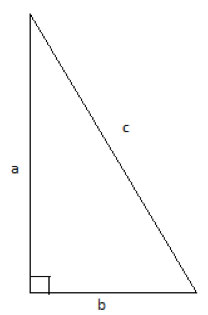This post will be a short and simple but very useful application of the general formula for finding the area of a triangle, to the specific case of a right triangle.
Problem
ΔABC is a right triangle with legs a and b, and hypotenuse c. Find a formula for its area using these sides.

Strategy
The general formula for the area of a triangle is the base times the height to that base, divided by two.
This usually requires us to draw a line, called height or altitude, from one vertex of the triangle to the side opposite it, which is perpendicular to that side.
But in a right triangle, these lines already exist- they are the legs of the triangle. By definition, a right triangle has a 90° angle between its legs, so they are perpendicular to each other.
The height to leg a is b, and vice verse, the height to leg b is side a. So the area of a right triangle is simply the product of the two legs, divided by two: a·b/2
Let's see a simple application of this - finding the area of a rhombus, given the lengths of its diagonals. We know that in a rhombus, the diagonals are perpendicular to each other, partitioning the rhombus into 4 right triangles.
We also know that the diagonals bisect each other. So each of these 4 triangles has an area of [(half of one diagonal) x (half the other diagonal)]/2, or diagonal1 x diagonal2/8.
But we have four of these in the rhombus, so the area of the rhombus is, as we have seen elsewhere, the half product of its diagonals.
